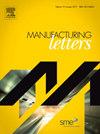电化学放电加工 (ECDM) 过程中火花的无监督检测和映射
IF 2
Q3 ENGINEERING, MANUFACTURING
引用次数: 0
摘要
电化学放电加工中的材料去除是由浸泡在电解溶液中的工具产生的火花引起的。作为这种非接触式加工过程中的主要加工剂,绘制微观火花位置图具有重大意义。与加工参数(如外加电压、刀具尺寸、旋转速度和进给速度)相比,刀具表面周围的火花分布可以让人深入了解加工孔的特性,如尺寸、表面光洁度和深度。本文的重点是在使用高速相机拍摄的 ECDM 过程照片中检测火花。本文尝试了一种新方法,即使用三平面反射面,利用二维相机输出捕捉三维空间中的火花位置。传统的火花检测方法使用神经网络分类器,需要标注数据进行训练。这些标注数据通常来自人工干预,并包含可能导致误分类的固有偏差。本文展示了一种无监督火花检测方法,该方法无需人工干预,而是依赖于感兴趣区域(ROI)中检测到的相邻像素数量。这项工作证明了使用自适应背景建模对数千张图像进行分类并识别出带有火花的图像的可行性。在每幅图像中,我们使用了结合侵蚀和扩张效果的遮蔽技术来确定火花轮廓的准确边界。然后将每个轮廓的中心点从相机图像中观察到的倾斜坐标系转换为以工具为中心的三维正交坐标系。在 ECDM 过程中,对不同的电压重复同样的过程,以确定刀尖周围火花的分布情况。本文章由计算机程序翻译,如有差异,请以英文原文为准。
Unsupervised detection and mapping of sparks in the Electrochemical Discharge Machining (ECDM) process
Material removal in electrochemical discharge machining is caused by sparks generated in a tool immersed in an electrolytic solution. Being the primary machining agent in this non-contact machining process, mapping the locations of microscopic sparks is of great interest. The distribution of sparks around the tool surface could give insights into the machined hole properties like the size, surface finish, and depth as compared to the machining parameters such as applied voltage, tool size, rotation speed, and feed rate. This paper is focused on detecting sparks in photographs of the ECDM process captured using a high-speed camera. A novel approach of using a tri-planar reflective surface for capturing the location of sparks in 3D space using a 2D camera output is attempted. Traditional spark detection methods use neural network classifiers that need labeled data for training. This labeled data often comes from human intervention and contains inherent biases that could lead to misclassification. In this paper, an unsupervised spark detection methodology is demonstrated, which eliminates the need for human intervention and relies on the number of neighboring pixels detected in regions of interest (ROIs). The feasibility of using adaptive background modeling to classify thousands of images and identify the ones with sparks is demonstrated in this work. The masking technique combining effects of erosion followed by dilation is used to determine the exact boundaries of the spark contours in every image. Centroids for each of these contours are then transformed from the skewed coordinate system as observed in camera images, to a three-dimensional orthogonal coordinates system centered around the tool. The same procedure is repeated for various voltages to benchmark the distribution of sparks around a tool tip in an ECDM process.
求助全文
通过发布文献求助,成功后即可免费获取论文全文。
去求助
来源期刊

Manufacturing Letters
Engineering-Industrial and Manufacturing Engineering
CiteScore
4.20
自引率
5.10%
发文量
192
审稿时长
60 days
 求助内容:
求助内容: 应助结果提醒方式:
应助结果提醒方式:


